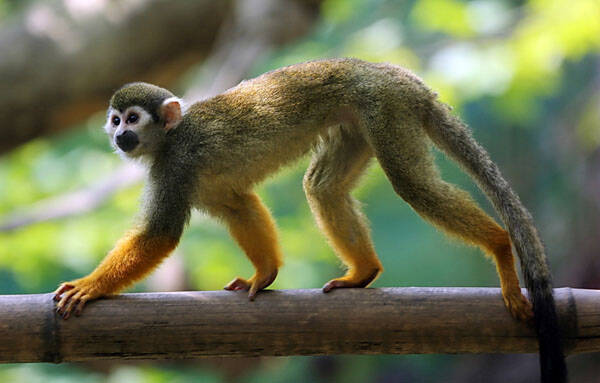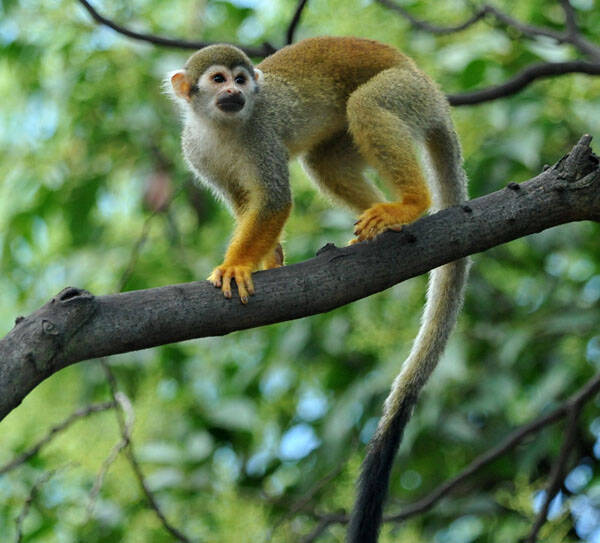Saimiri sciureus
IUCN
LCBasic Information
Scientific classification
- name:Saimiri sciureus
- Scientific Name:Saimiri sciureus
- Outline:Primates
- Family:C.monkeys S.monkeys
Vital signs
- length:20-40cm
- Weight:750-1100g
- lifetime:10-12years
Feature
It has a slender body, a long tail, and mostly golden fur.
Distribution and Habitat
Brazil (Amapá Amazonas, Maranhão, Mato Grosso, Counterpoint, Rayma, Tocantins River), Colombia, Ecuador, French Guiana, Suriname, Venezuela (Bolivarian Republic of).
Squirrel monkeys live in primary and secondary forests and cultivated areas, and in woods from sea level to 1,500 meters above sea level, usually near streams.
Appearance
The body length of a squirrel monkey is 20-40 cm, but the tail is up to 42 cm long. The weight is 750-1100 grams, but the ratio of brain to body weight is extremely high, 1:17, while humans generally have only 1:35. Squirrel monkeys are slender, with long tails, thick and soft fur, and bright and colorful body colors. The rim of the mouth and snout are black, the eye circles, ear rims, nose bridge, cheeks, throat and both sides of the neck are white, and the top of the head is gray to black. The back, forelimbs, hands and feet are red or yellow, and the abdomen is light gray. They have a pair of large eyes with wide eye spacing and a pair of large ears. The tail can be wrapped around the branches, which is very ornamental.
Details
Squirrel monkeys (scientific name: Saimiri sciureus) have 4 subspecies. They are small monkeys native to South America. They are easy to domesticate and can reproduce. They are gradually becoming pets.

Squirrel monkeys live in primary forests, secondary forests and cultivated areas, usually near streams. Squirrel monkeys are arboreal animals, occasionally moving on the ground. They are active during the day, usually in groups of 10-30, sometimes up to 100 or more. Each group has its own territory, and uses the secretions of the anal glands as boundaries. They are lively and active, usually jumping from branch to branch.
Squirrel monkeys are omnivorous animals, feeding on fruits, strawberries, nuts, flowers, flower buds, seeds, bird eggs, insects and small vertebrates. Among the New World monkeys, squirrel monkeys are the only species that stay on the ground for a long time. They come down from the trees to look for insects or collect fruits growing low.
Squirrel monkeys have 26 kinds of calls, which are quite varied. For example, when looking for food, they make chirps and chirps to communicate with each other; when mating, they make rattles and low vibrating sounds; when angry, they make roars.

Squirrel monkeys mate from September to November each year, with a gestation period of 160-170 days. They give birth to one baby each year, and the baby monkeys can climb after birth. Males reach sexual maturity at 4 years old, and females at 2.5 years old. Female squirrel monkeys will take care of their offspring until they become independent, while males will not participate in feeding their offspring. Lifespan is 10-12 years.
Squirrel monkeys are kept as experimental animals, and the supply is relatively stable, making them a relatively easy-to-obtain species. Because of their small size, they are not greatly affected by human hunting, but humans keep them as pets and the expansion of human activities has caused their numbers to decline. Squirrel monkeys can be seen in protected areas in Brazil, Colombia, Ecuador and other countries.
Listed in the CITES II level protected animals of the Washington Convention
Listed in the 2008 Red List of Endangered Species of the World Conservation Union (IUCN) ver 3.1 - Least Concern (LC)
Protect wild animals and eliminate game.
Maintaining ecological balance is everyone's responsibility!








